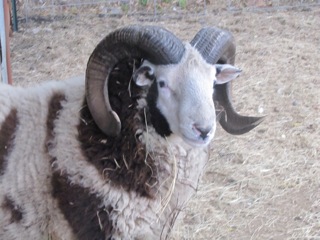 |
| Samson's Fleece on the Hoof |
Let me show you how I usually skirt my raw Jacob fleeces, to take best advantage of all its unique qualities.
First, we lay the fleece out on the screen skirting table, cut ends down. We see what we saw on the sheep before shearing - the outside of the fleece. We can see all the grassy areas, and the coarse, icky areas.
I work my hands all around the outer edge of the fleece, finding the places where the wool is not as soft as I'd like. I pull out grass and burrs, super dirty parts, felted bits, and short cuts.
Around the edge of the fleece that came off the animal's back legs, we find a good-sized coarse area called the "britch." On most sheep, this is the least desirable wool. You can see how harsh and hairy it looks.
Once most of the bad stuff is removed, I flip the fleece over to see the cut side. You can see that the wool is much cleaner close to the skin. Samson has nice bright white wool and deep black wool - some Jacobs are browner or grayer than this.
The second cuts, or the tiny bits of wool that are caused by the shearer going twice over the same spot, are easy to see when they stick to the opposite colored wool. We pick those off and toss them to the birds, for nesting material.
On a pure white sheep, we'd be done at this point. But with these spotted Jacobs, we have a couple of options: we can wash and blend all the wool together into a nice heathery roving that looks gray, or we can sort the wool into three different piles - the white wool, the black wool, and the wool along the color borders that is too intermingled to separate cleanly. Samson has more white than black wool, so I'll start with the white. In the picture above, I've started pulling the large section of white wool (lower right corner) away from the black spots, getting pretty close to the black without pulling any of the black into the white. I use a motion I call "Pac Man hands" to pull and part the fiber into the clear color groups. This takes time and patience.
See, now I have the largest pure white areas pulled away from the black spots. Now, I spread the remaining fleece out and work from the inside of the black spots, making sure I don't get any white mixed in. This leaves the wool that's just too hard to separate cleanly - a mixture of black and white. How much wool you leave in this "mixed" group is completely up to you. I try to work pretty fast, and I don't mind a large amount of mixed colors.
Here are my three bags full - black, white, and mixed. These batches are ready to be washed. When they're clean, we can continue to remove any grass or short bits that have not been separated out yet. The mixed wool, when carded, will become a gorgeous heathered gray. With three different colors of wool from one sheep, you can see that the possibility for natural colorwork is vast - fair isle patterns, stripes, mosaic knitting -- you name it.
If you haven't ever tried spinning or knitting with Jacob, I highly recommend giving it a go. Your fiber fingers will shout for joy!



